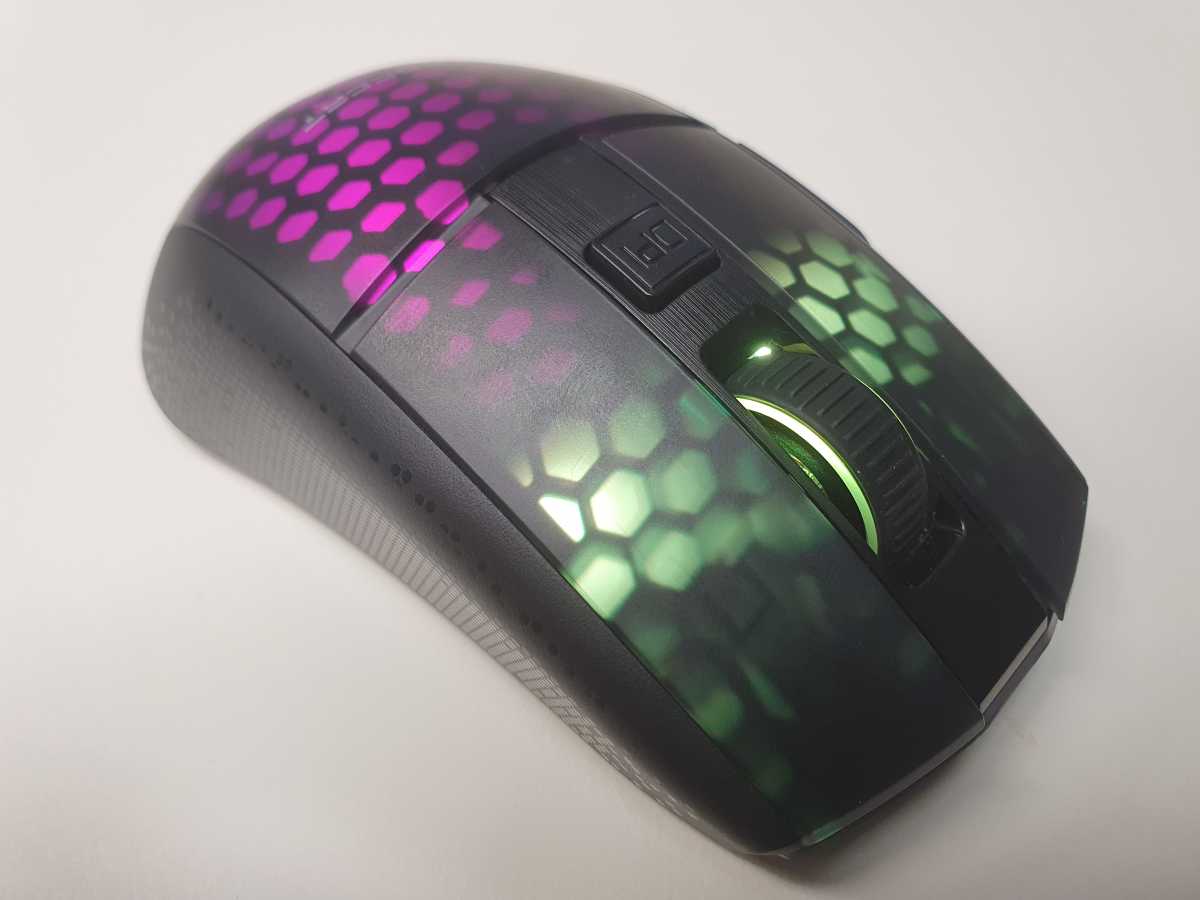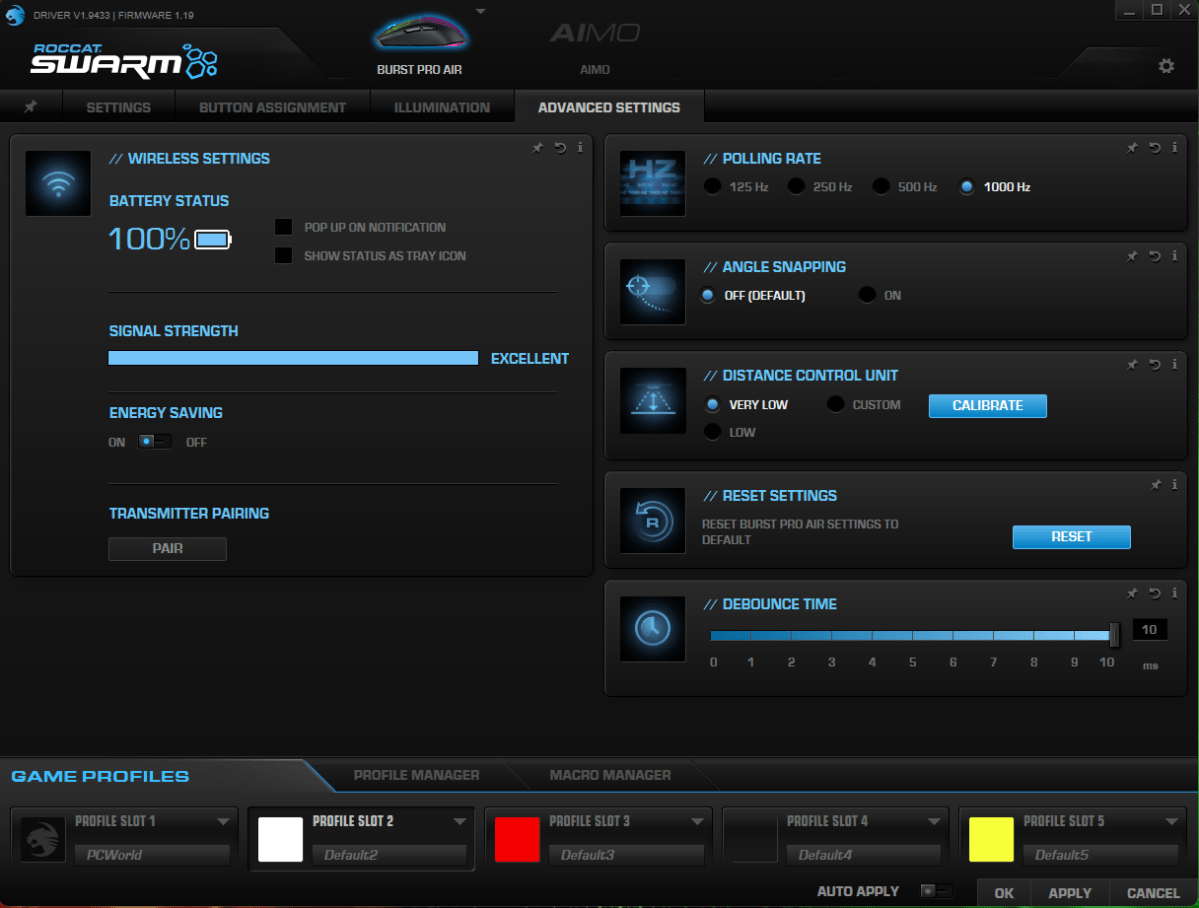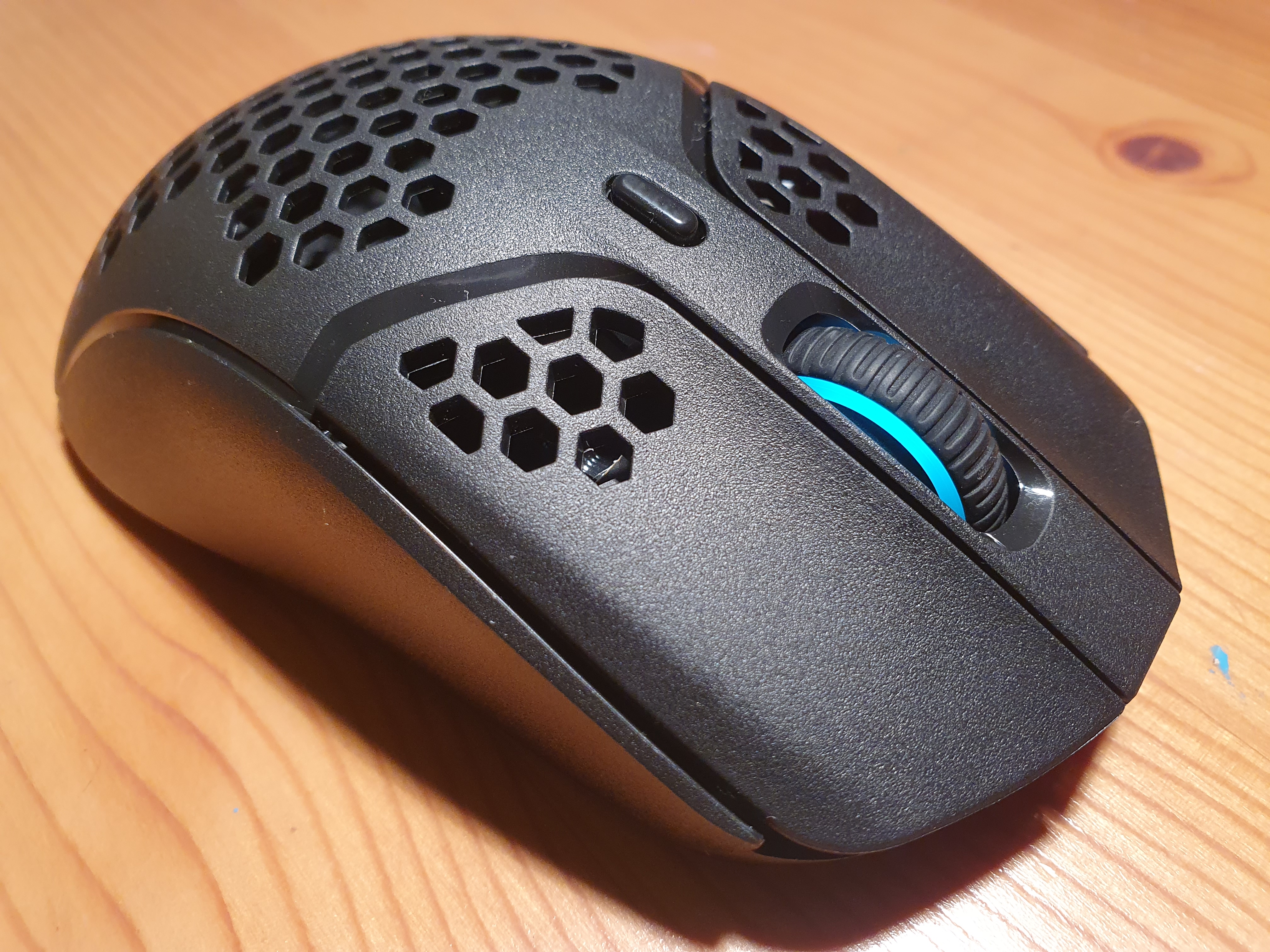Expert's Rating
Pros
- Owl-Eye sensor is very precise and quick
- You won’t find a mouse with more stunning RGB lighting
- Dual wireless as well as wired connectivity
Cons
- 81-gram weight can feel heavy if you’re used to a lighter mouse
- Mouse wheel lacks left and right lateral clicks
- Pricey compared to some rivals
Our Verdict
The Burst Pro Air could just be Roccat’s most versatile gaming mouse, offering up a compelling mix of dazzling RGB, decent gaming performance, and excellent connectivity.
Best Prices Today: ROCCAT Burst Pro Air
The Roccat Burst Pro Air occupies a comfortable niche in Roccat’s line-up, being arguably the most aesthetically pleasing and an excellent performer in games. More precisely it packs four stellar RGB lighting zones as well as a precise 19,000 DPI sensor and dual wireless and wired connectivity.
That said, there are a few downsides: It’s both heavier and pricier than rivals like the HyperX Pulsefire Haste Wireless and the Razer DeathAdder V3 Pro. But as I found out, these compromises are worth tolerating for a gaming mouse that performs so well and offers as much versatility as the Burst Air Pro does.
This review is part of our ongoing roundup of the best gaming mice. Go there to learn about competing products, what to look for in a gaming mouse, and buying recommendations.
Roccat Burst Pro Air: Design and build
Unboxing the Burst Pro Air revealed what looked like a straightforward symmetrical, FPS-style gaming mouse. However, its “special something” soon burst into view—literally—in the form of its stunning RGB lighting.
Roccat buried a honeycomb grid just below the surface of the mouse’s semi-transparent plastic outer layer—a design that creates a dazzling RGB glow that’s mesmerizing from every angle. But once you switch off the RGB, it’s all black again—the Pro Air will fit in just as easily next to your office PC as it will your gaming rig.
The four independent Roccat AIMO RGB lighting zones consist of two at the back and one under each of the main clicks. Consequently, you can light up the whole thing spectacularly or have fun changing up which zones are illuminated and how. There are 16.8 million programmable RGB colors to play with too, as well as some neat visual effects available in the Swarm software app.

By customizing the Pro Air’s RGB in the Swarm app you can get some stunning visual effects.
Dominic Bayley / IDG
While the fashion among gaming mice tends to be flared main buttons, by contrast the Pro Air’s two main clicks are tight rectangles. They stretch from the front all the way to its midsection. This makes it very easy to use if you’re a claw griper, since you can grip as far back as the center and your clicks will still register. Apart from the main clicks, you also get two left side buttons, a DPI button, and a mouse wheel in front of it—all of which seem ideally placed.
Palm gripping is super easy to do too since the Pro Air is nicely proportioned to rest against the top of your palm. Its 4.7 x 1.5 x 2.6-inch body fits snugly into your hand’s contours, feeling neither too small nor too big. The left-hand side buttons deserve a special mention, too, for being just the right size and shape for your thumb.
Two large, heat-treated PTFE glide skates make any movements across your mouse pad very smooth and effortless, and there are hexagonal grids flanking each side that serve as useful grips to prevent your fingers slipping—a bonus when your hand gets sweaty.
That said, the Pro Air’s design isn’t perfect. While it scores marks for size, it loses a few points for its 81-gram weight. Just last year 81 grams would have been considered quite light for an FPS gaming mouse, but releases like the 62-gram Razer DeathAdder V3 Pro and the 63-gram Logitech G Pro X Superlight have set a new benchmark for what constitutes lightweight.

RGB lighting zones beneath each of the Pro Air’s main buttons illumiate your fingers as you use it.
Dominic Bayley / IDG
In general, this advance has been reflected in prices, with mice that exceed the 70-gram mark being some of the more affordable now. This makes the Pro Air’s $79.95 shelf price look a little high. That point really hits home when you compare it to the HyperX Pulsefire Haste Wireless, an excellent FPS gaming mouse that weighs just 61 grams and costs only $50 USD.
Despite this, most rivals lack at least one of the Pro Air’s features: The V3 Pro, for instance, has no RGB lighting, whereas the HyperX Pulsefire Haste Wireless doesn’t offer as many connectivity options. So while the Pro Air might not be the cheapest or lightest gaming mouse you can buy, it certainly is an all-rounder that goes the extra mile.
Roccat Burst Pro Air: Connectivity
The Burst Pro Air differentiates itself from its near sibling, the Roccat Burst Pro, by sporting wireless as well as wired connectivity, which means it’s a go-anywhere mouse that you can just as easily use plugged into your home gaming rig as you can unplugged on a laptop you take to your friend’s house.
Additionally, you get not one, but two wireless options—Bluetooth 5.2 as well as low-latency 2.4GHz Wi-Fi—which adds to its versatility as a mouse that you can use for work as well as play. By comparison, the HyperX Pulsefire Haste Wireless offers only a low-latency 2.4GHz Wi-Fi option as well as wired connectivity.
Switching between connectivity modes is simple, requiring just the flick of a switch on the underside. In these unplugged modes, the Pro Air is rated for 100 hours battery life, which is more than enough to get you through a handful of gaming sessions, or even a midweek work trip.
For a wired connection, Roccat provides you with a long 1.8-meter, flexible USB-C to USB-A cable that should service even the hardest to reach PCs. This cable also doubles as a fast-charging cable when you’re out of battery, and it comes with a neat plastic protector to keep the USB-A side free of water or dust.
A discrete dongle storage port on the underside of the mouse is also a nifty inclusion that makes losing your USB-A receiver a little harder to do.
ROCCAT Burst Pro Air: Software
The Burst Pro Air makes use of ROCCAT’s Swarm app, which is where you’ll need to go to assign commands, create the five on-board profiles and customize the RGB lighting colors or effects. ROCCAT have made this fairly easy to do with submenus that you can easily navigate through, and thanks to a recent update the app looks modern and more visually appealing than before.
In Swarm I was delighted to see that you can adjust the Pro Air’s debounce time, which is a feature you won’t see in all gaming mice. This makes the Pro Air a good option for Sandbox-style games where debounce rates are particularly useful. Or if you’re into spreadsheeting, you may even find a use for this feature for rote productivity tasks like filling out columns in half the time.

You can customize the Pro Air’s debounce time in the Swarm software app.
Dominic Bayley / IDG
ROCCAT Burst Pro Air: Performance
The Pro Air packs a Roccat Owl-Eye optical sensor which tracks movement at 19,000 DPI and at 400 IPS (inches per second). It’s based on the PixArt PAW3370 sensor, which for your reference, is considered an excellent option for FPS gamers.
To test it out, I fired up the PC and sunk a decent amount of time into Counter-Strike: Global Offensive and Call of Duty: Modern Warfare II. No matter what kind of action I faced, the Pro Air kept me competitive. Thankfully, I didn’t notice any lag, even while pulling off large sweeping movements or spinning to face foes, and it just as easily handled the short, sharp flicks I needed to pull off to precisely target foes from far away.
The Pro Air’s symmetrical shape gave it a very predictable feel and made it super easy to judge how far to move my crosshairs. The mouse wheel was also a pleasure to use, proving wobble free and highly responsive. It gives you three commands—a forwards and backwards scroll function, and a downwards click, which were ideal for changing weapons or tossing grenades and flashbangs.
I did at times find myself wishing it also had left and right tilt functionality which would have been highly useful in games like Rainbow Six Siege, where peeking around corners is easier to do with a four directional wheel. Still, it was easy enough to assign extra commands to my keyboard, and gamers who need the left and right lateral wheel inputs, or otherwise more commands, can always opt for the Roccat Kone XP instead, a mouse which does both of these things extremely well.
The buttons also deserve solid praise. They felt soft and light to press, and their low-latency optical switches, which are rated for 100 million clicks, actuated my clicks instantly. I also attribute the Pro Air’s low latency response, to some degree, to its support for the Nvidia Reflex technology, which may have done a lot to optimize my click-to-display latency also.

Button assignment in the ROCCAT Swarm app.
Dominic Bayley / IDG
My only nit-pick about the Pro Air, if I had to name one, is that it can very rarely overshoot the mark when carrying out super precise maneuvers. This doesn’t happen a lot, but the one time in one thousand when it does, can be a little off-putting.
This could have been due to the inertia of its 81-gram weight or the fact that I had become accustomed to the much lighter HyperX Pulsefire Haste Wireless, so I may have been pushing it a little over-enthusiastically to compensate. Regardless, it’s worth noting, nonetheless.
Should you buy the Roccat Burst Pro Air?
If you’re looking for the lightest FPS gaming mouse at the cheapest price possible, then the Pro Air won’t match the likes of the HyperX Pulsefire Haste Wireless, or some other rival FPS gaming mouse that may beat it on both of those fronts.
On the other hand, for just a bit more pocket change and a few extra grams weight, the Pro Air give you a mouse that has more dazzling RGB, more connectivity options, and performs equally as well in fast-paced games. Plus, it’ll pass as an attractive work companion when you want it to, something that many FPS mice simply can’t do—yet another reason this mouse should win tons of fans.




